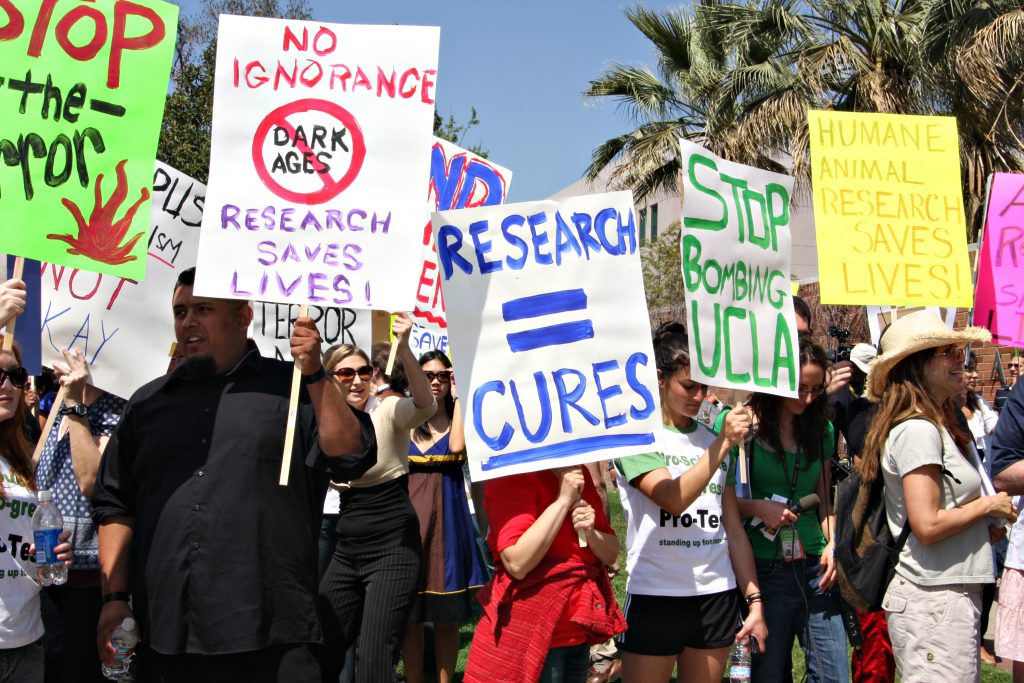Many people may not know this, but animal research has played an important role in almost every major medical advancement of the last century. The list includes antibiotics, blood transfusions, chemotherapy, dialysis, insulin, organ transplantation, heart bypass surgery, joint replacement, vaccinations, how a cancer gene works, new vaccines, and many more treatments that help stop suffering.1 These treatments are based on knowledge attained through research with lab animals. We have been able to learn and understand a great deal in the field of science and medicine through this testing; however, it has been at the expense of innocent animals. Although there are alternatives to animal testing, living organisms are very complex, and the only way to learn more is through research on other complex organisms that possess the same traits.
The many discoveries that have occurred, based on animal testing in the nineteenth century, have had a significant impact on how we live and view medicine. There are still a lot of questions, and even unknown questions in the field of science and medicine, that can benefit us in the same way they have in the past; therefore, animal testing should be continued for this purpose only. There are laws that protect animals and the amount that can be used and how they are treated to prevent cruelty. Many people who test on animals conduct their research with the obligation to keeping the animal safe. Their research uses as few animals as possible, and only when necessary, and in designed experiments that yield valid results and use the best possible methods and treatments.

Animal experiments were used in the discovery of anesthesia. Humphrey Davy demonstrated that nitrous oxide produced a reversible state of unconsciousness in animals. Through many trials, Davy led to the conclusion that animals could survive for long periods in an atmosphere of nitrous oxide mixed with air, and he consistently inhaled the gas himself. He noted on one trial that the gas actually relieved his toothache. In his book, published in 1800, Davy concludes: “As nitrous oxide in its extensive operation appears capable of destroying physical pain, it may probably be used with advantage during surgical operations in which no great effusion of blood takes place.”2 Later on, in the 1820s, Dr. Henry Hickman continued the experiments a stage further by performing surgery on animals under a state of carbon dioxide or nitrous oxide. Hickman tried to interest the medical field in the possibility of preventing pain during surgery by inhalation of these gases. However, he was ignored. More than twenty years later, the dentist Horace Wells, under nitrous oxide anesthesia, had a wisdom tooth removed by his partner Riggs. The nitrous oxide was administered by Quincy Colton, who was a medical student making his living by exploring the effects of laughing gas on members of the audience at stage shows.3 Before the laughing gas parties or ether frolic in the 1840s, the work of perfecting general anesthesia was already in play and being tested on animals.

Another critical discovery, very prominent in the lives of many today, is insulin. Studies using experimentally-induced animal models of diabetes were done to discover that insulin could be used to treat diabetes.4 The experiments began in 1921 by Frederick Banting and Charles Best. They began experimenting by removing the pancreas from a dog. The dog became thirsty, drank lots of water, and urinated more often. The dog became weaker and weaker. They found that this was due to the removal of sugars from the urine of the dog, whose pancreas had been previously removed, which is a typical animal model of diabetes. Experimenting on another dog, Banting and Best surgically ligated the pancreas, which stopped the flow of nourishment. This was so that the pancreas degenerated. After some time, they removed the pancreas, sliced it up, and froze the pieces in a mixture of water and salts.5 When the pieces were half frozen, they were ground up and filtered. The isolated substance was named “isletin.” This extract was then injected into the diabetic dog. Its blood glucose level dropped, and it seemed healthier and stronger. By giving a diabetic dog a few injections a day, Banting and Best could keep it healthy and free of symptoms.6 With continuing research, however, the extracts were found to be toxic. This caused a serious fever in both the dogs and diabetic patients. A biochemist named James Collip partnered with them and prepared insulin from the pancreas’ of cows and pigs. James Collip used alcohol to extract insulin, which produced several different protein solutions. He then needed to find out how much insulin was present in each solution. This was done by measuring their activity by injecting each solution into rabbits and monitoring their blood sugar levels. Collip developed a measure of activity based on the ability of the extract to lower blood sugar in the rabbit, which was used to standardize extracts. The three scientists, Collip, Banting, and Best’s extracts were used successfully in dogs and then in patients in 1922 with exceptional results. Millions today depend on this discovery, because insulin helps keeps blood sugar levels from getting too high or too low. Insulin regulates how the body uses and stores glucose and fat, and many of the body’s cells rely on it to take glucose from the blood for energy. It is very important and many people who have diabetes depend on this discovery.

Moreover, like many medical advances, the making of the heart-lung machine depended heavily on animal research.7 The cardiopulmonary bypass pump, or heart-lung machine, can take on the role of the heart and lungs during cardiac surgery. Opening up a person and being able to operate on a heart is extremely difficult and requires precise movements. As with any surgery, any wrong move or wrong cut can cause severe damage and even death. The machine allows for blood to bypass the heart while surgeons work. It is attached to the veins that feed the heart and to the arteries that leave it, where it draws blood from a patient just before it reaches the heart.8 In 1931, John Gibbon began to investigate the possibility of building an external device that could do the job of the heart and lungs for a short period of time. The research initially began using cats and developing a machine that could replace the function of a cat’s heart and lungs for twenty minutes.9 Unfortunately, not many of the cats survived longer that twenty-three days after surgery. Gibbon’s World War II army service in the China-Burma-INBM Theater temporarily interrupted his research. The research then continued with dogs, where initially the survival rates were low. He used a new series of experiments with dogs in the 1950s, using IBM-built machines. The new device used a new method of cascading the blood down a thin sheet of film for oxygenation, instead of the original technique that could potentially damage blood corpuscles. These experiments revealed the need to add filters to the heart-lung device to prevent blood clots. The dogs began surviving and the heart-lung machine was eventually prepared for use in humans. In 1953, the first successful operation on a human, using the heart-lung machine, was performed. Cecelia Bavolek underwent an open-heart bypass surgery, where the machine totally supported her heart and lung functions for more than half the duration.10 Today, this machine, which was perfected through many animal experiments, is commonly used to do the job of the heart and lungs for many hours, allowing for complex cardiac surgeries to take place. This machine is also used in keeping patients alive during heart transplants, and supported premature babies.
Animal testing has helped researchers discover or improve drugs and treatments, which have improved health and medicine. As mentioned, many medical treatments that many people heavily depend on today have been made possible by animal testing. Scientists and researchers are, of course, not allowed to experiment on humans, so the other route to go is on animals. In fact, 71 of the Nobel Prizes for Medicine won in the last 103 years were awarded to scientists who used animals in their research. There is still a lot to learn in the field of science and medicine, so animal research is still necessary in order for there to be advances.
- Salem Press Encyclopedia, January 2016, s.v. “Animal Testing,” by Joel McClellan. ↵
- R. Sharpe, The Cruel Deception, Chemical and Philosophical, The Chiefly Concerning Nitrous Oxide (Johnson: London, 1800), 159. ↵
- Thomson Guedes, The Self-trained pioneer Anesthesiology (JC, 1956), 93. ↵
- Michael Bliss, The Discovery of insulin (Chicago: University of Chicago Press, 2007), 304. ↵
- Subbroto Kumar Saha, “Recent Advances in Disease Modeling and Drug Discovery for Diabetes Mellitus Using Animals,” International Journal of Molecular Sciences 17, no. 2 (2016): 14. ↵
- Nobel Media, February 2009, s.v. “The Discovery of Insulin.” ↵
- “Animal Testing is crucial for science,” The Belfast Telegraph (Belfast, Northern Ireland 2016). ↵
- Andreia Cristina Passaroni, “Cardiopulmonary bypass: development of John Gibbon’s heart-lung machine,” The Brazilian Journal of Cardiovascular Surgery 30, no. 2 (2015): 238. ↵
- Andreia Cristina Passaroni, “Cardiopulmonary bypass: development of John Gibbon’s heart-lung machine,” Brazilian Journal of Cardiovascular Surgery 30, no. 2 (2015): 238. ↵
- Walter Gomes, “The Brazilian Registry of Adult Patient Undergoing Cardiovascular Surgery, the Bypass Project,” Brazilian Journal of Cardiovascular Surgery 32, no.2 (April 2017): 73. ↵



82 comments
Auroara-Juhl Nikkels
I am not against animal testing, I am against the abuse of animals that are being used in the lab. I think that precautions need to be taken. Overall, your article was very informative and very good. I think it helps people keep their minds open and be aware of what is going on in the world and where we would be without animal testing.
Hanadi Sonouper
Having an interest in science and experimenting, this article was new and informative. It was definitely an interesting descriptive article to read, especially because it had to do with the testing on animals. Before reading this article, I had some knowledge that animal testing took place to evaluate the progress on drugs regulated by the FDA, however as an animal lover myself, I do believe that they are worthy of no cruelty or testing. But, in order to progress further into the field of medicine and research, the need for testing is required to find cures and therefore save lives. It was interesting to read how animal research has played a crucial role in their lives and ours, hopefully as our medical expertise and technology advances there will no longer be a need for the testing on animals.
Anais Del Rio
To be honest, I never stopped to think that medicine we used today was tested on animals, I thought it was tested on people who volunteered. This opened my eyes to the reality of all the things we have and that the things we enjoy and need were created thanks to animals. It is sad to see that innocent creatures are being used to make advancements but without sacrifice we would not be where we are or maybe even alive.
Michael Thomas
I found this article interesting because of how it details why animal research has brought new cures for diseases. In most of my courses, I have learned that using animals for research has increased our knowledge of genetics and development. Animal activist should understand that without animal research, there would be no cures for illnesses or diseases. Yet, animals involved in research should only be used for improving our knowledge of life and finding cures for diseases.
Angelica Padilla
The article caught my attention, especially since I am a huge animal lover. I would hate to see any of the animals in such terrible conditions because of the testing done on them. I do hope that somewhere in the future there is another alternative to help test for medical advances. It is difficult because of the harming of animals touches a lot of soft spots for many people, but it’s crazy how they are being tested because of the complex traits we share that helps allow us to get results.
Cheyanne Redman
I am a complete animal lover, and it absolutely breaks my heart to see animals get tested on, but without that very testing our medical advances would not be where they are today. The title of this article really caught my attention, I was very intrigued on what is said. I believe this author did a very good job with presenting the boundaries of such experiments and why they should be implemented. I hope one day that we will be able to find an alternative method in the future, though.
Alexandra Lopez
Just the title of this article alone caught my attention. Animals are innocent and cute but advances in medicine and products we use today are because of animal testing. As an animal lover, it pains me to see animals in such terrible conditions. I do know that because animals are, of course, not able to make their own decisions, there’s the IACUC. The Institutional Animal Care and Use Committee protects the animals of any harm and reserves rights for them as well. Knowing that animal testing is needed to advance our resources, the development of IACUC is extremely important. I do see the advantages of animal testing.
Caroline Bush
Great article! I personally love animals but I do see the big picture that is if we don’t use them for testing than we would not have some of the medical advancements we have today. I do think that if the testing is just and the animal isn’t in more pain than it needs to be than the testing it ok. However I do think that there are certain situations where I think it is unjust to test on animals. Overall great article and you did a great job conveying a good point about a controversial topic.
Hector Garcia
I had never that much attention to animal research, but I am glad that it has brought us this far. Although most people believe that animal research is cruel, they aren’t able to see that big picture. These animals helped to develop insulin into what it is today. It has even contributed to development of methods such as the organ transplantation, dialysis and chemotherapy. I enjoyed reading this article and was able to learn the brief origins of animal research.
Benjamin Arreguin
Animal testing is one of the necessary evils that moves humans in the right direction to become smarter about how we deal with medicine, beauty products, and treatments for health conditions. It is very rare to find an article that explains why animal testing does have a positive side, and describes what is necessary to advance our everyday medicinal uses and cosmetics.